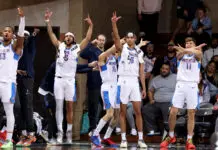We have scheduled maintenance for our cars, and the handy monitoring systems let us know when they need to be serviced. Unfortunately for humans, our bodies don’t come conveniently equipped with a dashboard to light up when something may be amiss. Dry skin, waist size, creaky joints and even dry eyes can all be signs of underlying health issues. While most of the time these symptoms should not be cause for alarm, you should always be alert to what your body is trying to tell you.
As new studies are published and picked up by the media, it seems that anything and everything can be a sign that some health disaster is looming in your future. From having a longer ring finger than the forefinger being an indication that you have a higher probability of developing osteoporosis, to the shape of your body and sense of smell, it seems that new information about health issue probabilities is released daily.
“The pendulum changes so often,” says Dr. Jenny Le, a family medicine specialist with OU Physicians in Edmond.
“It used to be pear-shaped bodies were healthier than apple shape bodies, but a recent study has refuted that, saying basically that large amounts of fat anywhere aren’t good.”
Le says she tends to take the latest and greatest medical finds published in supermarket health magazines with a grain of salt, preferring to stand by the studies that have years of research behind them.
“There are certain truths to old wives’ tales – there is something in chicken soup that makes you feel better and aloe vera is good for burns. But, I don’t buy into most of it.”
While it’s not likely that your doctor is going to be examining the lengths of your fingers to develop a case history, your body does communicate with you in numerous ways. We’ve asked doctors about some common complaints and what they could mean.
Symptom: Cold Hands
According to Le, having cold hands doesn’t necessarily mean anything. However, consistently cold hands could indicate poor circulation.
“Definitely go see a doctor if having cold hands is outside your normal or if you have a tingling sensation. It could be nerve damage-related.”
Treatment:
First thing’s first: If you have cold hands, bundle up. If the coldness persists or becomes tingly, your doctor will work with you to establish a medical history and devise a course of action. Sometimes, something as simple as watching your salt intake can help.
Symptom: Irritability When Hungry
Do you notice that you get increasingly cranky or you’re not as focused as it gets further and further away from the last time you ate? You could be expressing the indicators for hypoglycemia. Other symptoms can include heart palpitations, tremors, anxiety and sweating.
Treatment:
For most, simply eating curbs the irritability, while your doctor can confirm if what you’re experiencing is hypoglycemia. According to the Mayo Clinic, if you have diabetes and early signs of hypoglycemia don’t improve with eating or taking glucose tablets, seek immediate help.
Symptom: Leg Cramps
“Leg or muscle cramps can be tricky,” says Le. “If you’re experiencing muscle cramps after a bout of physical activity, that’s par for the course. You also may have a low potassium level or restless leg if there’s no rhyme or reason to the cramps.”
Treatment:
“We’ll likely draw a blood level to see what’s going on with your potassium. That’s the biggie – deficient potassium can lead to heart problems. But most patients that I see have increased their activity level in some way,” says Le.
Symptom: Energy Slumps
Feeling down and not so peppy? Experiencing prolonged energy slumps can be the signs of an underlying thyroid issue.
“When a patient comes in and complains of decreased energy, it could be thyroid-related or an imbalance of iron levels in their blood,” says Le. “Patients may can also be depressed. It’s really important to look at the big picture to determine potential causes for these symptoms.”
Treatment:
According to Le, a blood panel will likely be taken to determine if the thyroid is functioning properly or if the blood is low in iron. Additional treatment options can be as simple as a vitamin B-12 shot or amending your diet and adding exercise.
“Sometimes the solution for loss of energy is as easy as starting an exercise routine. When you get exercising, you’re using your own endorphins. Also, eating a lot of junk food can make you feel sluggish. If that’s the case, you really need to examine what kinds of foods you’re consuming.”
If your funk is more likely due to depression, your doctor may prescribe anti-depressants or other forms of medication to get you feeling back to normal.
Symptom: Creaky Joints
If there is pain, swelling, redness or warmth at the joint, it could be gout or rheumatoid arthritis. Hopkins says that typically normal osteoporosis does not present with fever. Which type of creaky joint you have will dictate the course of treatment.
Treatment:
If there is pain, swelling, redness or warmth at the joint, it could be gout or rheumatoid arthritis. Hopkins says that typically normal osteoporosis does not present with fever. Which type of creaky joint you have will dictate the course of treatment.
Symptom: Dry Skin
“Medical providers view the skin as a barrier,” says Dr. Stephen Hopkins of Mercy Clinic Northwest Expressway.
“A lot of this stuff is what we’re doing to ourselves – soap, body wash and such. Dry skin can be benign or something more serious, such as psoriasis.”
According to Hopkins, dry skin coupled with constipation or other symptoms can also be a signal of a thyroid issue.
Treatment:
Solutions can be as simple as switching soap and daily moisturizing. Psoriasis is treatable through creams and medication.
“Dry skin could just be a sign that you’re getting older – your skin loses its ability to hold moisture,” says Le. “I love putting Vaseline on damp skin to trap in the moisture. It’s cheap and it works.”
If you’re experiencing dry skin coupled with other symptoms, it’s important to tell your doctor, as it may be related to an underlying issue.
Symptom: Snoring
“Typically, if someone comes into my office and says their spouse is complaining about their snoring, we’ll go over a history to determine if a sleep study is warranted,” says Hopkins. “It can be that the snoring is caused by allergies, or could it be from sleep apnea.”
Treatment:
If you’re one of the many who keep their spouse awake at night due to snoring from allergies or inflamed nasal passages, nasal strips might help. If it is sleep apnea, which is the halting or stopping of breathing during sleep, and goes untreated, it can lead to much bigger issues such as heart disease.
Symptom: Chronic Coughing
According to both Le and Hopkins, the reasons for experiencing chronic coughing can be as varied as the designs of a kaleidoscope.
“If there is something that needs to be sought for medical evaluation, it would be chronic coughing,” says Hopkins. “It can be asthma, it could be cancer, tuberculosis – even some medications can cause chronic coughing.”
“It could be a byproduct of acid reflux or if you’re a smoker it can be even worse,” adds Le.
Treatment:
Both doctors say that assessing a patient’s medical history is important to finding the root cause of the coughing to provide the appropriate course of treatment.
Symptom: Changes In Your Nails
“Changes in the fingernails and toenails may be suggestive of underlying systemic disease,” says Hopkins. “Spoon-shaped nails may indicate underlying iron disorder or anemia, a club shaped deformity of the nail might indicate underlying lung or bowel disease, and small nail hemorrhages might suggest heart disease especially in the conjunction with a heart murmur. Pitting of the nail may reflect psoriasis, and yellow, discolored nails may indicate fungal infection and sometimes something more serious: problems with the lymph system, kidneys or other systemic diseases.”
Treatment:
Depending on what you’re experiencing, your treatment can be varied. If the changes in your nails are fungal related, they most likely can be easily treated through medication.
The biggest thing, both Le and Hopkins caution, is that it is important to be aware of any changes in your body.
“If you have something ongoing for more than a few weeks, go get it checked out,” Le says. “I’m never upset about a patient coming in to see me about any concerns they might have. You are the person who knows what’s going on with your body better than I do so don’t underestimate what you know. Just have your concerns addressed by someone in the medical profession.”
“Pain is an important indicator,” adds Hopkins. “Anytime there’s pain it’s your body’s indicator that something is going on.”
Additional symptoms that you might want to have checked out by a health provider include new moles, yellowing of the skin, dramatic changes in weight and rashes on the face. Increased thirst and urination can be early warning signs of diabetes. Both Hopkins and Le say that any and all chest pain should be taken seriously and any lump or mass should be looked at immediately.
“Early detection can save your life,” adds Hopkins. “Some signs are more subtle and some are more obvious. Like a car’s check engine light, people should get their questions answered.”
More About Thyroid Disorders
It is estimated that approximately 20 million Americans suffer from some form of thyroid disorder, and that at least half of those cases are undiagnosed. Symptoms such as fatigue, weight gain and foggy thinking are often attributed to factors such as stress, unhealthy diet or other illnesses when a faulty thyroid gland may be to blame.
The thyroid gland is a small endocrine gland situated in the front of the neck that is responsible for maintaining proper metabolism – the rate at which the body uses energy. While somewhat inconsequential in size, it is surprisingly powerful. When the thyroid gland doesn’t function properly, the body is deprived of essential hormones needed to regulate things such as body weight, heart rate, body temperature and brain function.
Due to the thyroid gland’s all-encompassing effects on the body, symptoms of thyroid disorders are often far-reaching and difficult to pinpoint.
“Thyroid disorders may be difficult to diagnose based on symptoms alone because many of these symptoms are nonspecific and may be associated with a multitude of other disease processes,” says Dr. Erin Kratz of OSU Medical Center.
Common Disorders
The most common disorder of the thyroid gland is called hypothyroidism, or under-active thyroid. Symptoms typically include fatigue, dry skin, hair loss, constipation, cold intolerance and weight gain. Cognitive difficulties are also sometimes associated with a sluggish thyroid, as well as a diminished sense of smell, taste or hearing.
Hypothyroidism is most often caused by an autoimmune disorder called Hashimoto’s Thyroiditus, which causes the body’s immune system to attack the thyroid gland and inhibit thyroid hormone production. In some cases, hypothyroidism may also be caused by the pituitary gland failing to produce enough TSH (thyroid-stimulating hormone), which essentially tells the thyroid what to do and when to do it.
Hyperthyroidism, or overactive thyroid, is less common than hypothyroidism, but can be equally debilitating. Symptoms commonly include increased heart rate even when resting, heat intolerance, weight loss, tremors and more frequent bowel movements. While basic blood tests may be used to diagnose hyperthyroidism, an iodine uptake and scan may be needed to identify the specific cause. The most common cause of hyperthyroidism is Grave’s Disease, which is an autoimmune disorder similar to Hashimoto’s that causes the immune system to attack the thyroid gland and trigger an increase in the amount of thyroid hormones released. The most prominent symptom of Grave’s Disease is known as exophthalmos, or a swelling of the eyes that causes a visible protrusion of the eyeballs themselves.
Treatments
Hypothyroidism is traditionally treated with a daily oral hormone replacement, such as Levothyroxine, Synthroid, Levothroid or Levoxyl. Once medication has been prescribed, thyroid levels are then monitored every few weeks, and medication dosage may be adjusted in order to determine the adequate amount needed for healthy thyroid function in each individual patient.
Hyperthyroidism is commonly treated with oral medication or radioactive iodine, which helps inhibit thyroid hormone production. For more severe cases, or for those with thyroid nodules or thyroid cancer, the thyroid may be partly or completely removed surgically.
After thyroid disorders are treated, TSH levels typically return to normal, but some symptoms may take a bit longer to fade.
“Symptoms such as hair loss may take a longer time to resolve, even after laboratory tests return to normal,” says Kratz. “It may take a while to ascertain the right dosage of medication, as each individual will respond differently to treatment.”
Since treatment may not provide immediate and/or significant relief from symptoms, patients may sometimes assume it is not working, and request a higher dosage of medication or feel the need to increase their dosage themselves. However, too much thyroid medication can be dangerous.
“Too often, thyroid hormone levels are manipulated with medications based on symptoms without regard to the thyroid hormone levels,” says Dr. Peter J. Tebben of Mercy Health Center.
Symptoms should be evaluated carefully in order to ensure that thyroid hormone levels are really causing the problem before increasing dosage. “Taking too much thyroid hormone can cause serious health problems,” Tebben says.
Risk Factors
While anyone can develop a thyroid disorder, young and middle-aged women are most susceptible to thyroid problems, and it is often hereditary. The NWHIC (National Women’s Health Information Center) estimates that one in eight women suffer from a thyroid disorder.
Pregnant women are particularly prone to thyroid disorders, so it is important to monitor thyroid health both during and after pregnancy.
“Abnormal thyroid hormone levels during pregnancy may increase the rate of miscarriage and affect the neurological development of the child,” says Tebben. “Thyroid hormone doses may need to be increased by as much as 25 to 50 percent during the early phase of pregnancy and then be reduced again after delivery.”
Infants are sometimes born with hypothyroidism, but current newborn screening programs test for thyroid problems. Other high-risk factors include a family history of thyroid disease, postpartum women, those with pre-existing autoimmune diseases and/or those who have undergone radiation treatments.
While most North Americans typically consume enough iodine, a continued emphasis on low-salt diets and an increase in consumption of iodine-deficient processed foods may have put some at risk for iodine deficiency. The Institute of Medicine Food and Nutrition Board (IOM) recommends a dose of 90 milligrams per day for children, 150 milligrams per for adults and 220 milligrams per day for pregnant women. Good sources of iodine include iodized table salt, seafood, milk, yogurt and strawberries. There are also many vitamin supplements available that contain the recommended daily dose of iodine.
Regular checkups are recommended, since untreated hypothyroidism can lead to serious health problems including diabetes, heart disease, seizures and, in rare cases, even coma.
Hyperthyroidism that goes untreated can lead to problems such as cardiac arrhythmia, osteoporosis and toxicity to the liver, or thyroid storms.
The Thyroid Foundation of America recommends that women should have their thyroid hormone levels checked starting at age 50, and men should begin regular monitoring at age 60. Those over age 35 should have their thyroid checked every five years.
– Tricia Tate























